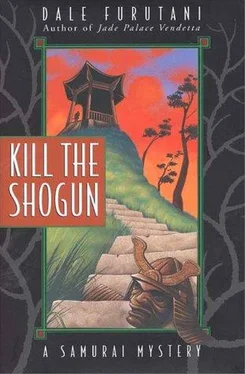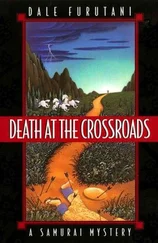Dale Furutani - Kill the Shogun
Здесь есть возможность читать онлайн «Dale Furutani - Kill the Shogun» весь текст электронной книги совершенно бесплатно (целиком полную версию без сокращений). В некоторых случаях можно слушать аудио, скачать через торрент в формате fb2 и присутствует краткое содержание. Год выпуска: 2011, ISBN: 2011, Жанр: Исторический детектив, на английском языке. Описание произведения, (предисловие) а так же отзывы посетителей доступны на портале библиотеки ЛибКат.
- Название:Kill the Shogun
- Автор:
- Жанр:
- Год:2011
- ISBN:0688158196
- Рейтинг книги:3 / 5. Голосов: 1
-
Избранное:Добавить в избранное
- Отзывы:
-
Ваша оценка:
- 60
- 1
- 2
- 3
- 4
- 5
Kill the Shogun: краткое содержание, описание и аннотация
Предлагаем к чтению аннотацию, описание, краткое содержание или предисловие (зависит от того, что написал сам автор книги «Kill the Shogun»). Если вы не нашли необходимую информацию о книге — напишите в комментариях, мы постараемся отыскать её.
Kill the Shogun — читать онлайн бесплатно полную книгу (весь текст) целиком
Ниже представлен текст книги, разбитый по страницам. Система сохранения места последней прочитанной страницы, позволяет с удобством читать онлайн бесплатно книгу «Kill the Shogun», без необходимости каждый раз заново искать на чём Вы остановились. Поставьте закладку, и сможете в любой момент перейти на страницу, на которой закончили чтение.
Интервал:
Закладка:
Ieyasu wondered how many of his old guard, his original Mikawa bushi, ever thought they would go from obscurity to the rulership of Japan. It helped that Ieyasu had his health and a long life, but it also helped that Ieyasu had always harbored an ambition to be Shogun. Sometimes the vagaries of life’s twists and turns could be nudged in the right direction if you knew what your eventual goal was.
Time had linked Honda and Ieyasu together like nothing else can. They had seen many battles and defeated many enemies, one by one. Ieyasu trusted Honda implicitly, and he felt most comfortable when he was among rough warriors like Honda. But he knew the qualities that made Honda a valuable general in ruthless battle were not the qualities that would lead him to his eventual goal, establishing a dynasty. It would be the cultured warriors, the men like Nakamura, who would be critical to building a government that would outlast his lifetime.
Nakamura was a member of the group of nobles who had joined Ieyasu’s camp after Sekigahara, the tozama . Honda was a member of the fudai , the loyal retainers who had, over the years, helped Ieyasu reach the pinnacle of power. The tozama would always be a little suspect, especially ones like Nakamura, who were a bit too intellectual. Too much thinking by a vassal could be a dangerous thing to the person in power.
Still, despite his misgivings, Ieyasu knew he had to draw on men like Nakamura and similar types, such as Okubo, Toyama, and Yoshida, to set up a stable government. So far, Ieyasu had rewarded the tozama much more lavishly than the fudai. While a fudai vassal would get a fief of 30,000 to 50,000 koku , a koku being the amount of rice needed to feed a warrior for a year, a tozama vassal might get a fief five to ten times that size. This caused dissatisfaction amongst the fudai, but Ieyasu simply expected the fudai to be loyal. He felt he must buy the loyalty of the tozama and watch them closely in the bargain, too.
The previous two rulers of Japan, Nobunaga and Hideyoshi, did not have their dynasty last past their own lives. As with the dove, mortality intruded while they had their eyes set on the horizon. Ieyasu intended to have his dynasty live long past him, and he prayed to the Gods that he would have just a few more years to establish a firm foundation for the Tokugawa Shogunate.
Ieyasu was in his early sixties, but his age was a little misleading. He was born in the year of the Dragon, just five days before the change to the year of the Snake. Being born in the year of the Dragon was a most auspicious sign for a samurai, although his family was not then powerful. When he was born, Ieyasu was considered to be one year old. Every baby existed for almost a year in the mother’s womb, and, besides, Japanese logic dictated that no one could be zero years old. Just six days later, on New Year’s Day, Ieyasu, and everyone else in Japan, was considered one year older. Therefore, Ieyasu was only out of his mother’s womb six days, but he was considered two years old.
Ieyasu looked about the small meadow his party was in and said, “Let’s try our luck in that direction.” He pointed to the direction of the horse, due south. He handed the hawk to one of the falconers and set off in the direction he indicated.
When the hawking party was safely out of sight, the men hiding in the rocks came out.
“I know who now, but tell me when.”
“Tomorrow, Ieyasu-sama will make a formal inspection of how the work on the new castle in Edo is progressing. It’s a large, open site, with many buildings around its periphery. There will be a large entourage with Ieyasu-sama, all the key daimyo , and probably a large crowd will gather to get a glimpse of the new Shogun. You can do it then.”
“All right,” the first man said. “Consider it accomplished.”
CHAPTER 2
Balancing on a
narrow edge of shiny steel.
How confined is life.
The bright faces of children watched the battle intently.
“Give back the treasure!” the brave samurai said.
“I’ll never give it back!” the hairy ogre replied.
“All right, I’ve warned you! I shall take my sword ‘Ogre Killer’ and thrash you!”
“Owww! Owww! Owww! Itai! It hurts!” the ogre shouted.
And the children laughed.
The children were gathered around a kami-shibai , a paper play, and they were watching a new world unfold for them within the confines of a wooden box. The box was mounted on spindly wooden legs and it formed a miniature stage. A sheet of painted paper formed the backdrop, setting the scene for the battle in a fantastic forest of gnarled trees with brooding branches. Dark, painted shadows splayed out from the brown tree trunks, giving the appearance of a sinister spiderweb. The actors were two painted paper cutouts, pasted on bamboo skewers. The kami-shibai man manipulated the skewers as he spun his tales of warriors, myths, and monsters.
The children watched with rapt attention, chewing on cheap senbei , rice crackers, the purchase of which was the price of admission to the show. Near the edges of the crowd, a few ragamuffins stole pleasure by watching the show without purchasing a cracker, but today the kami-shibai man wasn’t concerned. Business was brisk because the crowd was in a festive mood, and the mood had infected all the food sellers and street entertainers who had converged to feed off the gathering.
The entire city of Edo had a boomtown feeling to it as the Tokugawas built their new capital. It actually helped that the entire city almost burned to the ground the year before, because it allowed the Tokugawas to think on a grand scale, laying out vast tracks of land for the mansions of dignitaries and building a new castle. After the fire, the lumber, tile, and stone merchants saw wealth pouring in as material was purchased to rebuild. The only ones who didn’t prosper were the thatchers, for the Tokugawas decreed that the roofs of the new Edo were to be made of wood or tile, but not straw, because a thatched roof was too combustible.
The Tokugawa victory at Sekigahara three years before cemented the primacy of their clan in Japan, and it allowed Ieyasu to claim the title of Shogun. A vast flood of humanity started flowing into Edo after Sekigahara, as the Tokugawas recruited skilled stonemasons, carpenters, and artisans of all types to help rebuild Edo on a scale suitable for the new rulers of Japan. The growth of highly paid merchant and artisan classes drew food vendors, prostitutes, street entertainers, gamblers, and thieves, all intent on profiting from the wealth that was in Edo.
From a sleepy fishing village, Edo was being transformed into the new capital of Japan. Now an Edokko , a child of Edo, was expected to have a free-spending view of life, with a love of luxury and pleasure. It didn’t matter if the person was not born in Edo, because being an Edokko was a state of mind, and within months most new citizens of Edo were caught up in the ebullient spirit that seemed to pervade the very air.
Ieyasu was known for his parsimony and considered waste an affront to heaven. He even had his ladies put their soiled tabi socks in a box. When the box was full, he would personally go through it, deciding which socks should be passed on to serving girls and which socks should be retired for rags. For a man of such character, the free-spending ways of his capital were troublesome. He made halfhearted efforts to suppress the profligate spirit of Edo, but nothing could stop the rising tide of optimism that fueled the Edokko’s spending.
Given the Edokko’s natural predilection to celebrate, almost any occasion was an excuse for a festival. This included the big and important occasions, such as New Year’s or O-bon, but it also included anything novel that brought people together. Today the occasion was a formal inspection of the work on Edo-jo, Edo Castle, the Shogun’s new stronghold, and a good crowd had gathered to observe the inspection, albeit from a distance.
Читать дальшеИнтервал:
Закладка:
Похожие книги на «Kill the Shogun»
Представляем Вашему вниманию похожие книги на «Kill the Shogun» списком для выбора. Мы отобрали схожую по названию и смыслу литературу в надежде предоставить читателям больше вариантов отыскать новые, интересные, ещё непрочитанные произведения.
Обсуждение, отзывы о книге «Kill the Shogun» и просто собственные мнения читателей. Оставьте ваши комментарии, напишите, что Вы думаете о произведении, его смысле или главных героях. Укажите что конкретно понравилось, а что нет, и почему Вы так считаете.












